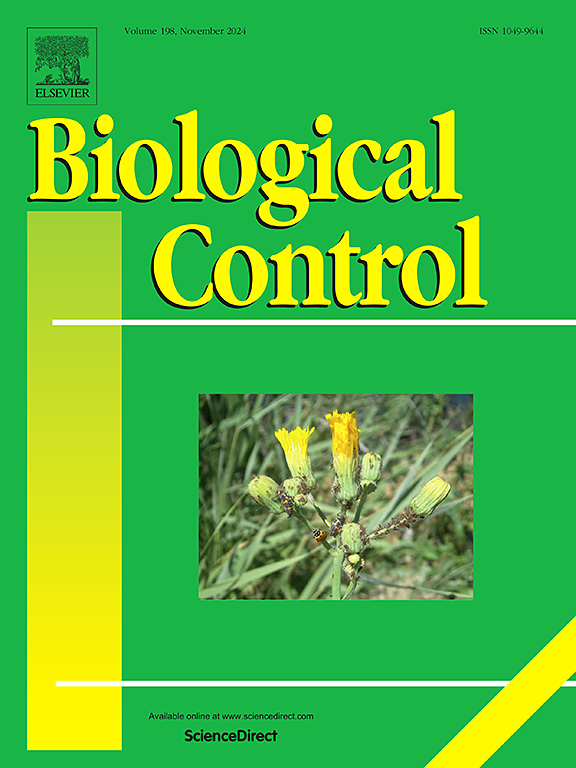甜菜作物蚜虫天敌生物防治的定量研究
IF 3.4
2区 农林科学
Q2 BIOTECHNOLOGY & APPLIED MICROBIOLOGY
引用次数: 0
摘要
保护性生物防治系统涉及到对作物有害生物具有重要调控作用的多种天敌群落。然而,在主要的作物害虫系统中,天敌的这些不同功能群对蚜虫调节的相对贡献知之甚少。此外,有必要确定这种贡献的时间,特别是当蚜虫能够将致病病毒传播给植物时,例如在甜菜作物中。在这项研究中,我们通过连续两年(2022年和2023年)进行的两次实验,量化了地面捕食者(瓢虫、蜘蛛、粉甲虫)和拟寄生物对甜菜作物蚜虫丰度的影响。基于物理隔离装置(陷阱、屏障、防虫笼),我们发现地面捕食者显著降低了蚜虫(fabae和Myzus persicae)的丰度。地面捕食者对自然害虫控制做出了重大贡献,因为它们使蚜虫的数量减少了80%,尤其是在季节早期出现的蚜虫。2023年测得的寄生率约为48%。我们的研究结果表明,这两组天敌似乎在蚜虫的调节中起着特别重要的作用,尤其是地面捕食者。这表明,作为植被覆盖的农田边缘,有利于多面手捕食者越冬或定居的农业实践可能会减少农民的损害和损失。本文章由计算机程序翻译,如有差异,请以英文原文为准。
Quantification of the biological control of aphids by their natural enemies in sugar beet crops
Conservation biological control system involves a diverse community of natural enemies that significantly regulate pests in crops. However, the relative contribution of these different functional groups of natural enemies to aphid regulation is poorly known in major crop-pest systems. Moreover, there is a need to identify the timing of this contribution, especially when aphids are able to transmit pathogenic viruses to plants, such as in sugar beet crops. In this study, we quantified the effect of ground dwelling predators (carabids, spiders, rove beetles) and parasitoids on aphids’ abundance in sugar beet crops, using two experiments conducted over two successive years (2022 and 2023). Based on physical exclusion devices (pitfall traps, barriers, insect-proof cages), we showed that ground dwelling predators significantly lowered the abundance of aphids (Aphis fabae and Myzus persicae). Ground dwelling predators made a significant contribution to natural pest control, as they lowered aphids’ populations by up to 80%, especially as they were present early in the season. Around 48% parasitism rate was measured in 2023. Our results suggest that both groups of natural enemies appear to play a particularly important role in aphid regulation, especially ground dwelling predators. This suggests that agricultural practices, as a vegetated field margin, favouring generalist predators overwintering or colonization could lead to fewer damage and losses for farmers.
求助全文
通过发布文献求助,成功后即可免费获取论文全文。
去求助
来源期刊

Biological Control
生物-昆虫学
CiteScore
7.40
自引率
7.10%
发文量
220
审稿时长
63 days
期刊介绍:
Biological control is an environmentally sound and effective means of reducing or mitigating pests and pest effects through the use of natural enemies. The aim of Biological Control is to promote this science and technology through publication of original research articles and reviews of research and theory. The journal devotes a section to reports on biotechnologies dealing with the elucidation and use of genes or gene products for the enhancement of biological control agents.
The journal encompasses biological control of viral, microbial, nematode, insect, mite, weed, and vertebrate pests in agriculture, aquatic, forest, natural resource, stored product, and urban environments. Biological control of arthropod pests of human and domestic animals is also included. Ecological, molecular, and biotechnological approaches to the understanding of biological control are welcome.
 求助内容:
求助内容: 应助结果提醒方式:
应助结果提醒方式:


